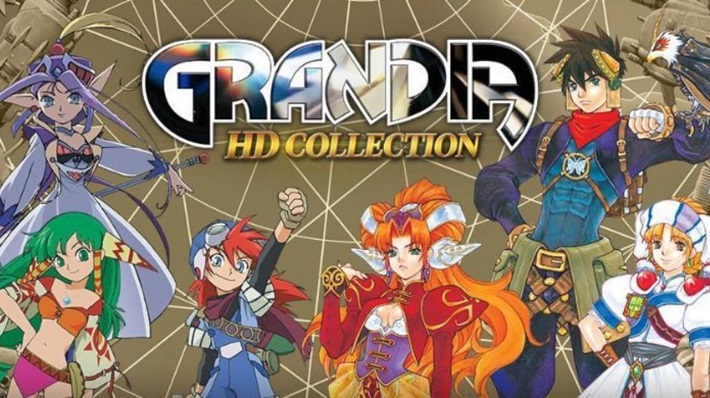
The JRPG genre has its titans, which inevitably means some end up in their shadow due to a lack of commercial success- despite high praise. The Grandia series of the late 90s and early 2000s was one many claim deserved better- at least for the first two mainline entries. Highly praised in their day, yet never reaching the dizzying heights like Dragon Quest or Final Fantasy. Years later, publishers and developers are catching onto the idea of bringing back old games with updated visuals, and a wider audience. Enter Grandia HD Collection, containing Grandia and Grandia II. While both games had received PC ports before (Grandia HD Remaster and Grandia II Anniversary Edition), the pair are now together on the Nintendo Switch. Should you take this call to classic JRPG adventures, or has it aged like milk?
Grandia HD Collection
Publisher: GungHo America
Developer: Game Arts
Platform: Nintendo Switch (Reviewed)
Release Date: August 16th, 2019
Players: 1
Price: $39.99

Grandia 1 focuses on young wannabe adventurer Justin, who still keeps his dream despite the discovery of “the edge of the world” making many feel there is nothing left to discover. While stumbling across evidence that a mythical land may exist from ancient ruins, he charges head-long into the new world to find it- with an entire military hot on his heels.
The overall story and dialogue is a throwback to classic JRPGs, and refreshing if you have not experienced it in a long time (or ever). Young and optimistic party members decrying older and jaded villains, quirky NPCs, and an overall light-hearted tone that still occasionally touches on darker themes.
Almost nothing has been altered for modern sensibilities either. Quite a few female NPCs want a man, and some male NPCs who are total horn-dogs. The game uses its original localization, meaning all instances of alcohol have been changed to coffee. While it is very poorly hidden, it almost adds to the charm.
An interesting feature of both games is how the party can sit-down over a meal and chat about events and each-other’s lives. Most of the time this focuses on the events, and some more focusing on the characters would have been nice. That being said, major character development happens during the game, and there was a limit on how much dialogue they could cram into the original.
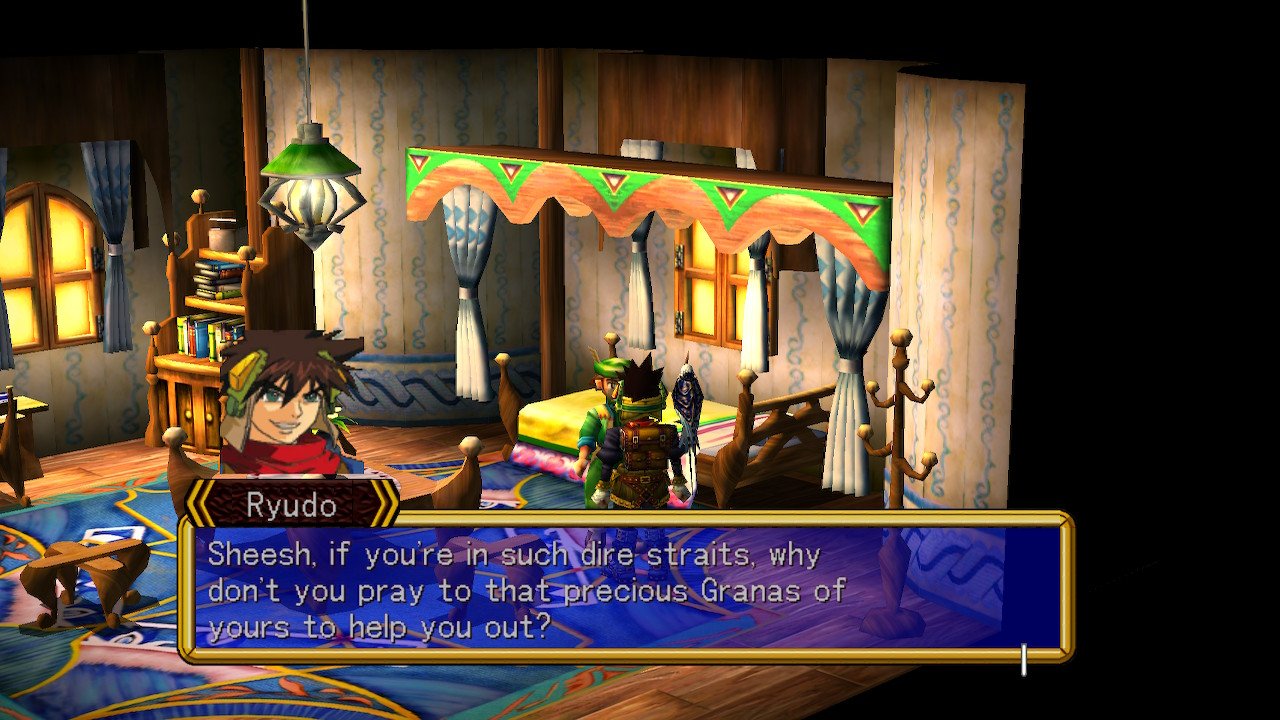
If Grandia 1 is akin to JRPGs you played as a child, Grandia 2 is the one you played as a young teen. After the god Granas destroyed the devil Valmar, many years of prosperity occurred for humanity. Now there are signs Valmar is returning- with failing crops and monsters roaming the night.
A “Geohound” (mercenary) called Ryudo is on a mission to escort a priestess to a ritual. When it all goes wrong, Ryudo gets pulled into a mission to prevent Valmar’s return. All the while snarking every step of the way.
While Justin has an infectious joy about him, Ryudo is more “edgy”. Not emo or sadistic, but acting as though he has the whole world figured out, and constantly berating nigh-every single character he talks to. Even though the game does touch on why he is like this (and how Ryudo himself does not want to talk like that), it does make enduring him insufferable at times.
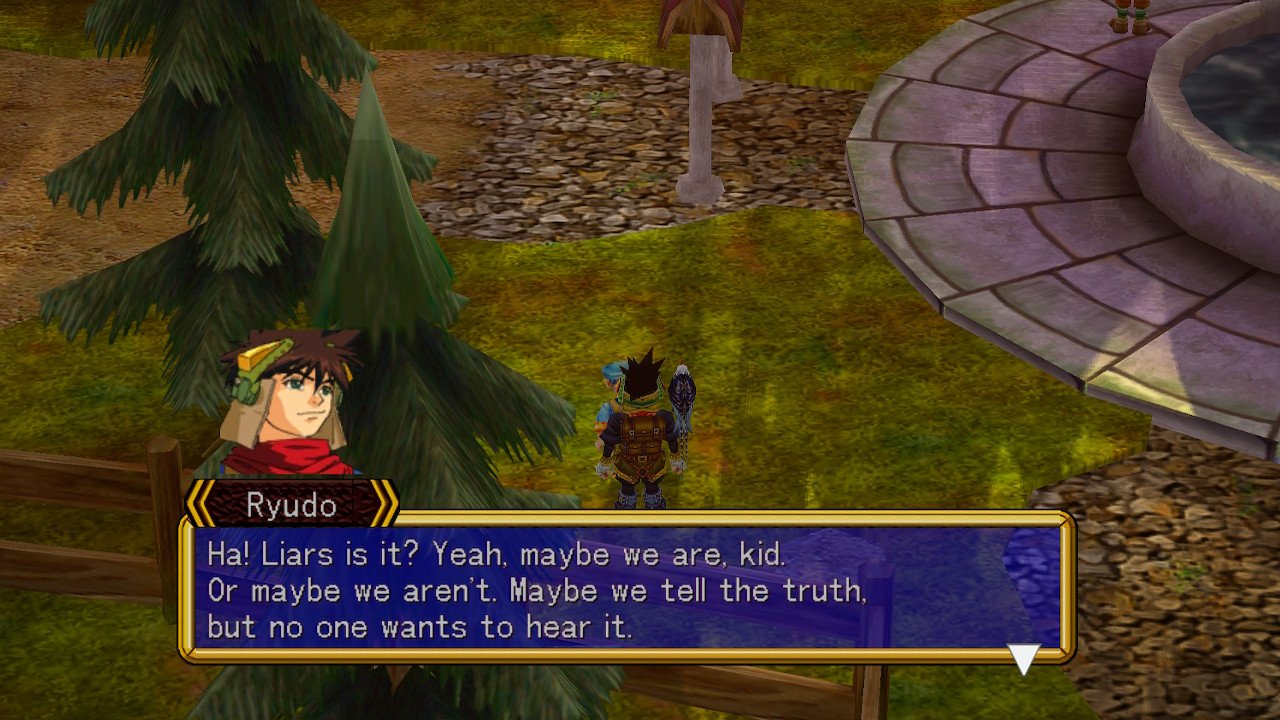
Justin’s character growth over the game feels more natural- a young man learning his romanticized view of the world is not accurate, but exchanging it for a deeper love of how exciting the world in spite of its flaws. Ryudo does become more openly caring over time, but too little and too late.
Both do form believable friendships with their respective parties (even Ryudo), filled with characters who seem to fit neatly into tropes at first, but gradually reveal they have more going on.
Both games have a lot of NPCs to talk to, even by a JRPG’s standards. Combined with how they often have multiple things to say- and how their dialogue changes after every event- you can easily rack up more time in town then in a dungeon. If you deem reading every possible line of dialogue as part of a game’s completion, this may quickly bore you to tears.
Both games are an enjoyable classic stories. A few points may be cliché by today’s standards, but it is still fun to experience. Even if you have to grit your teeth or mock Ryudo to cope with his story.
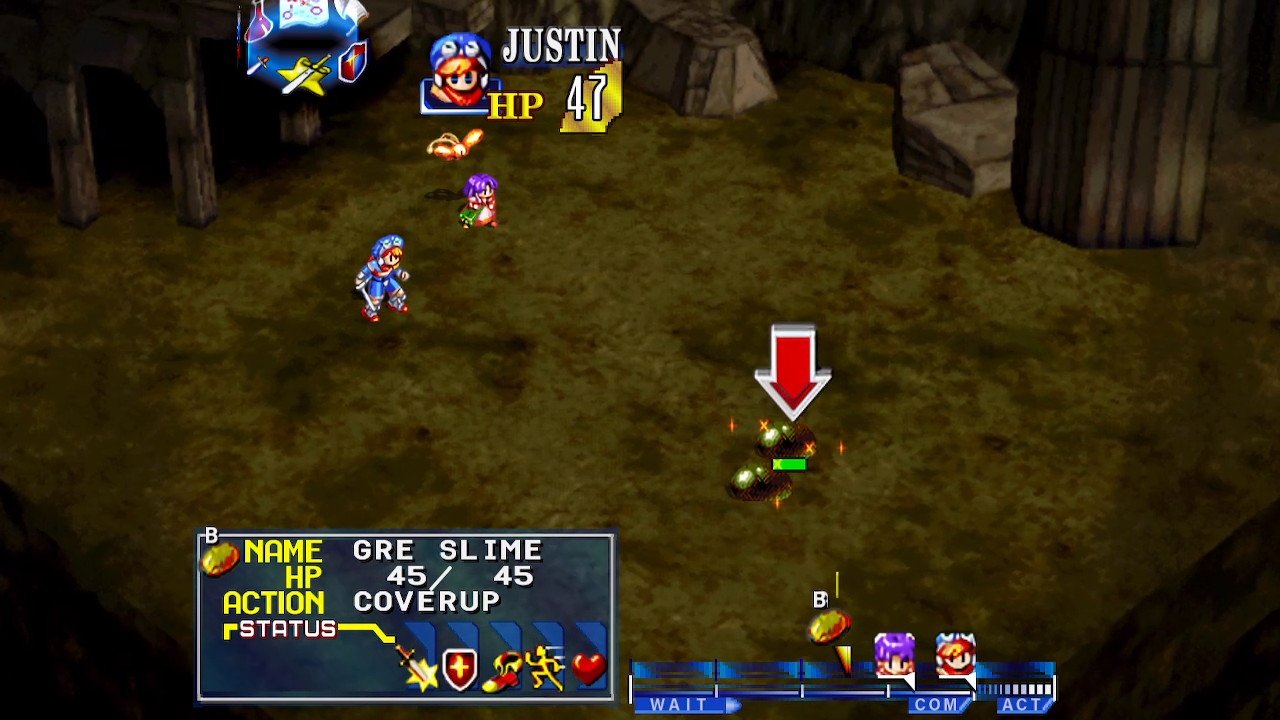
Gameplay is delightfully retro. As you walk through dungeons you can see enemies- if you run up their butt you ambush them and vice-versa. Unlike other games with similar mechanics, enemies can have their own movement patterns, or some AI that at least attempts to avoid being ambushed, or do the same to you.
Battles themselves utilize a system similar to the ATB system of some Final Fantasy titles. Character portraits progress across a bar, then perform an action when it gets to the end (enemies decide their action at the start, players decide just before the end).
Your basic attack can either be a combo or a critical. While combos deal more damage, you can cancel an enemy’s attack with slower criticals if it connects just before they execute it. Then again, you deal more damage with a combo at that time as well.
Even though you have no way to wait or time your attack, you still have some decision making to do by considering how long it will take your units to walk over and perform their action, and who the enemy is going to attack.
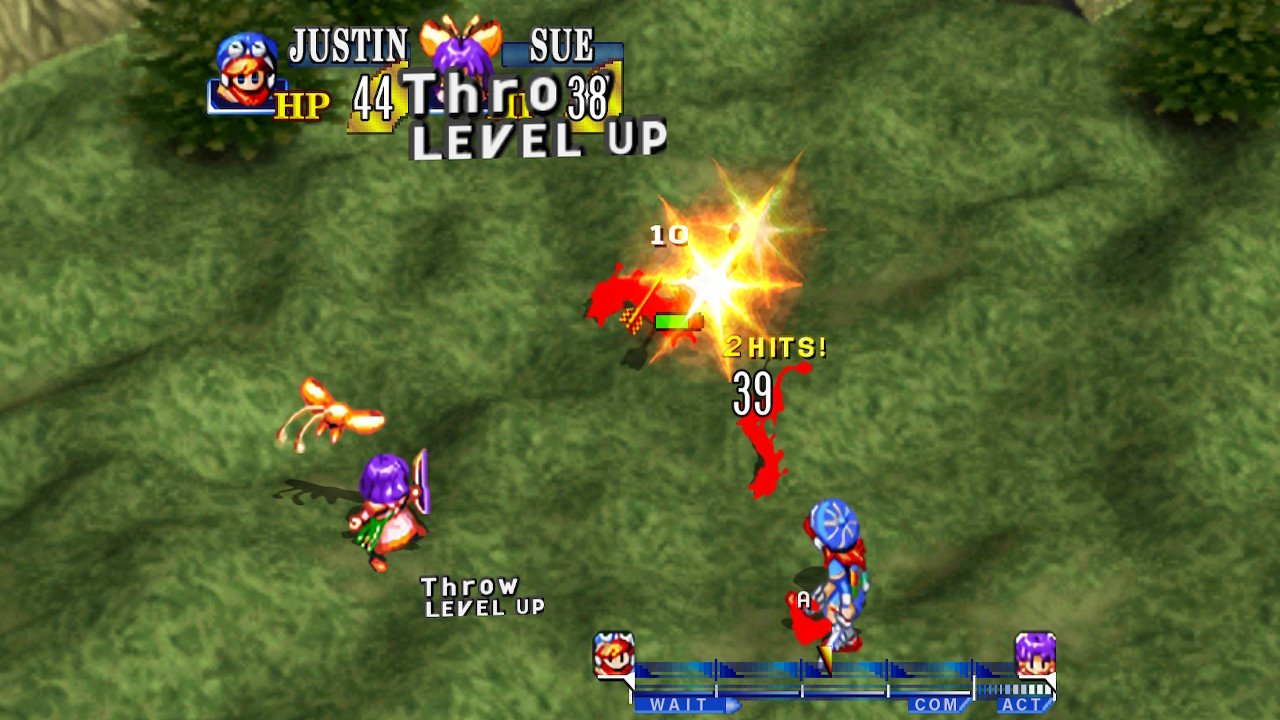
Enemies can also interrupt your moves, so you have plenty to consider. More damage, cancelling, protecting that character, healing or buffing allies- and all considering when enemies will act and against who.
While a better tutorial is needed (the save-point hints are outright need-to-know), the game is still easy. Cancelling an enemy’s action devastates them even if you only prevent every other attack. Combined with their low damage output, my characters rarely lost more than 1/5 of their HP against regular enemies, or a quarter against bosses.
This is further exacerbated by optimal play. Skills and magic improve the more you use them (taking less time to execute). SP recovers slightly with normal attacks, and MP only recovers from items or when you rest/recover. Despite this, it is still viable to use them constantly- even against regular enemies- making battles far shorter and those attacks even more effective.
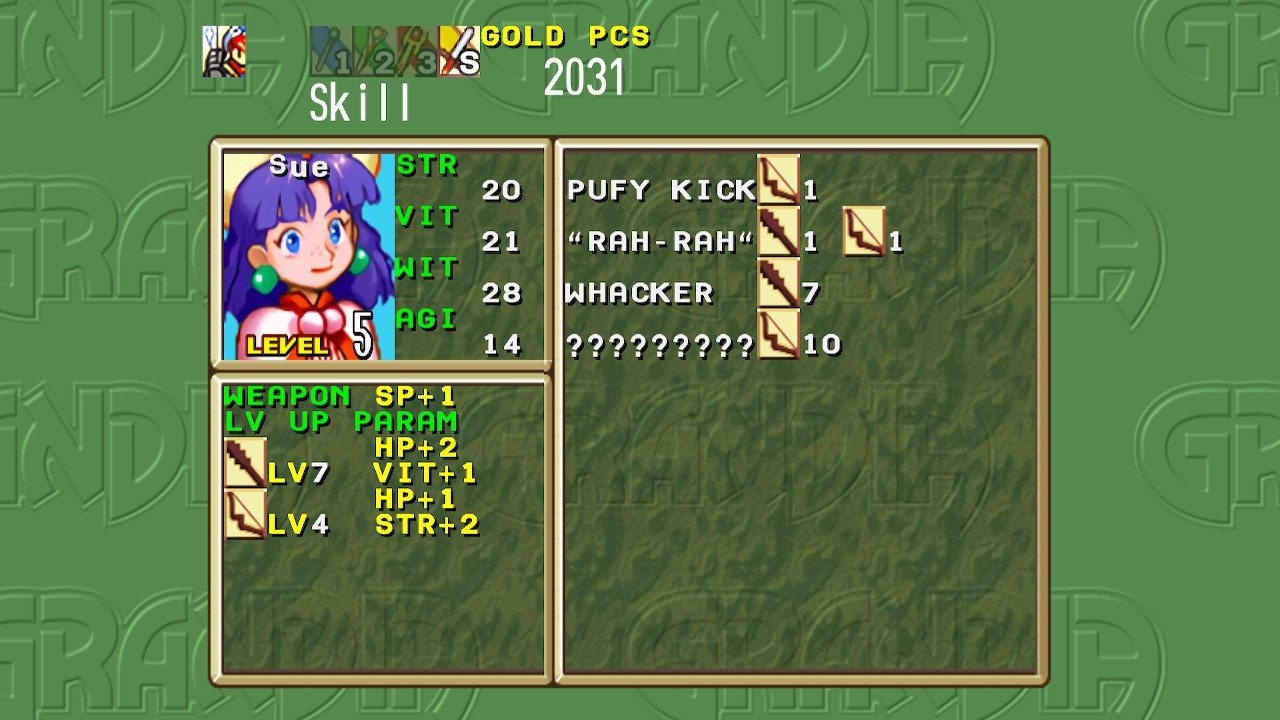
How you learn new abilities and magic is interesting. As you character improves their skill level with a weapon (and in turn gaining a small boost to their stats), they can gain more skills. For example, Level 7 in Maces and 5 in Axes gives Justin the Shockwave skill. So you find yourself rotating around what a character is equipped with to get their next skill.
Magic elements also improve as you use their spells, and getting a high enough level in certain elements creates new ones (such as water and wind for ice). Learning the magic elements is done via “mana eggs” and exchanged at shops.
The downside is while requirements to learn skills are shown (even if you have no idea what that skill will be), you have no idea what spells a character can use once they learn an element, or if they can learn a skill that requires both weapon and magic element levels.
That being said, you can eventually acquire enough mana eggs for all characters who can learn magic to gain each element (and of course, you can always save-scum before using the egg).
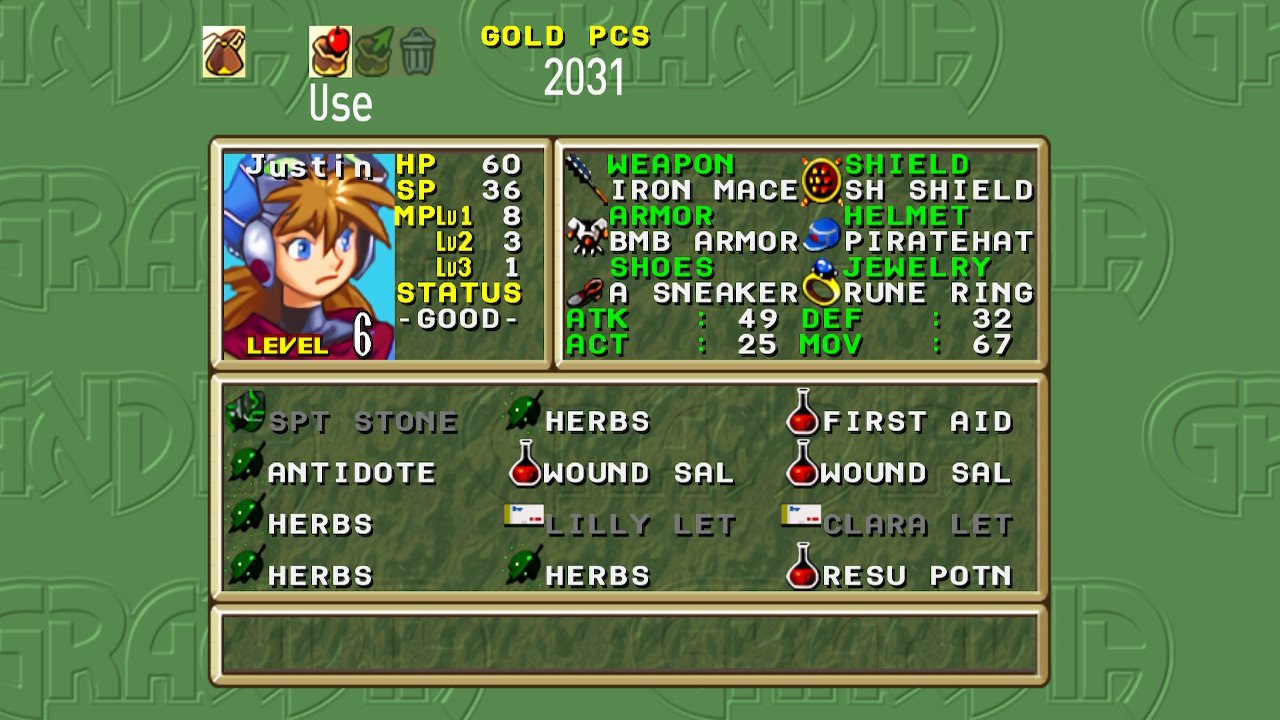
While combat can still be enjoyable despite its issues, one gripe is how the game handles inventory. Each character only has 12 inventory slots. All items not directly equipped onto a character must be carried- including key items.
Thankfully, you do have a storage in major towns and cities, but when picking up new items in dungeons, it can be a pain. For example, if you want to sell your old gear you just replaced with what you found in a dungeon, you would have to carry it until you leave. Though with the aforementioned issue with difficulty, you could risk carrying less healing items.
Speaking of dungeons, they are a delight to explore. This may be due to some modern games having linear maps designed too easy to navigate, but your paths through some of these dungeons really do twist and turn, and reward exploration with items.
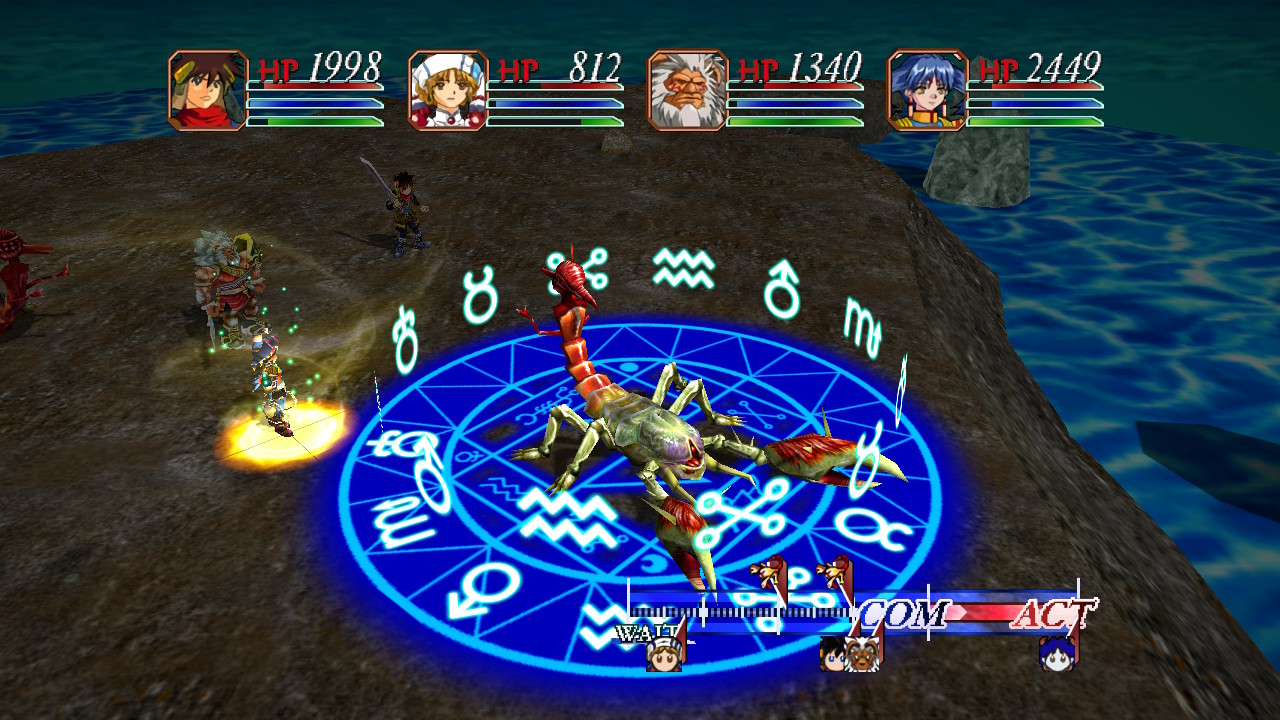
Grandia II does much of the above with some slight variations. Your inventory is shared and limitless like other RPGs, and characters only use one type of weapon. Enemies hit marginally harder, but even on hard mode (where enemies do more damage and take more to die) you take as little damage as in Grandia 1 if you cast a defense buff. Bosses however, can hit like trucks.
The major difference is how enemies drop Skill and Magic coins. These coins are more akin to experience points, but you can choose where to spend them (which characters’ skills). Likewise, using skills or magic causes more of their respective coins to drop.
Mana eggs are now a piece of equipment. As you improve and learn spells, it is the egg improving and learning. You can then freely reassign the egg as you see fit. Characters also start the game with more MP, meaning you can use spells much more frequently.
While gameplay may be easy (and there are a few gripes to deal with) the experience is still enjoyable and keeps you engaged by attempting to halt enemies in their tracks and develop your characters (or mana eggs). If the games’ story, characters, or aesthetic already tickled your fancy- you will still enjoy the gameplay it comes with.
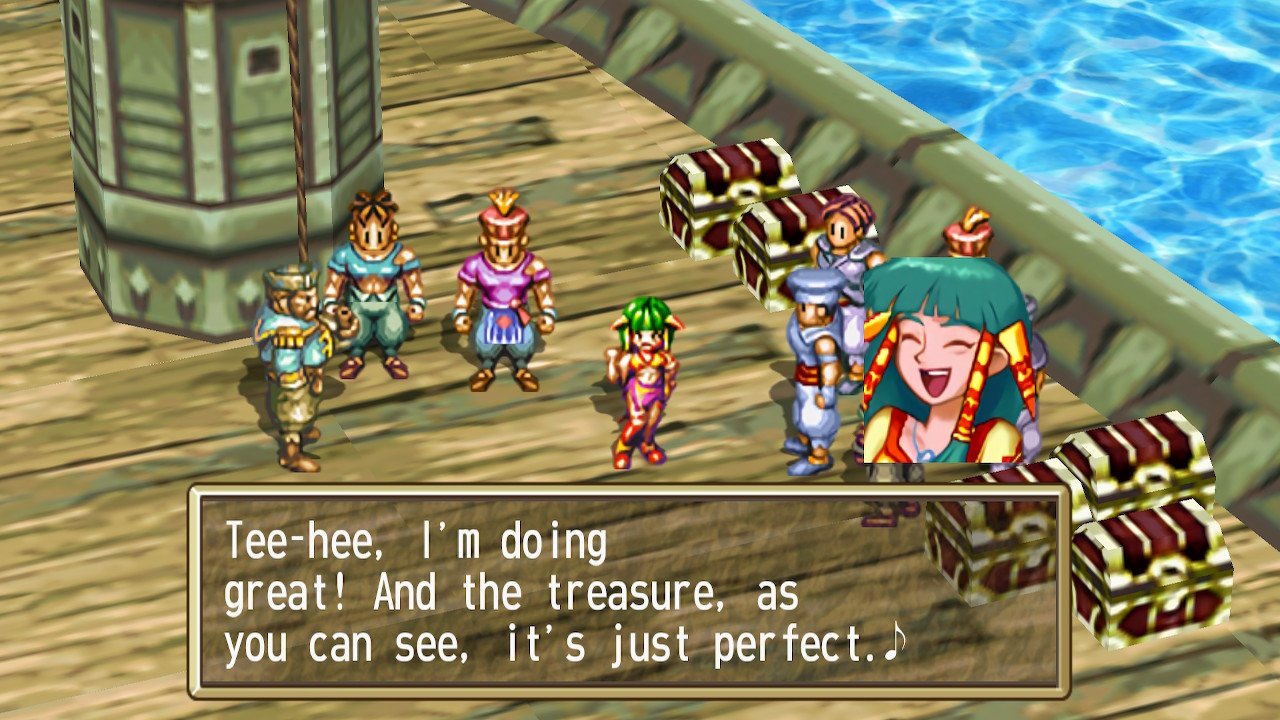
Both games rely on earlier PC ports with a few additions. Grandia 1 utilizes the PlayStation version of some effects (such as battle transitions), but a much smoother frame-rate like the Dreamcast. 3D models are crisp- even if they are just boxes. Menus and fonts have also been redone, and are the crispiest thing you will see across both games.
However, the collection is far from HD. Textures in Grandia 1- while bright and colorful- can be a little blurry, and with blatant seams and tiling. The battlefield screens are the worst offenders, looking like the original with how blurry they are. FMVs fill the aspect ratio by having a blurred version of the edge of the shot, filling the gap between 4:3 and 16:9.
Likewise, the sprites have had a filter put over them to “smooth out” the pixels. Instead of looking drawn, it looks like a blob on all but the smaller screen in hand-held mode. In one instance with a special animation, I saw what appeared to be the original sprite-work for a frame. Miraculously, the charm of the original sprites somewhat shines through.
While the frame-rate never dips (in both docked and handheld modes), there are some oddities. When the camera moves around in cut-scenes, sprites on screen will jitter and shudder. There is also a brief flash of solid black in the battle transition. While annoying when noticed, they are quickly dismissed once you get into the game.
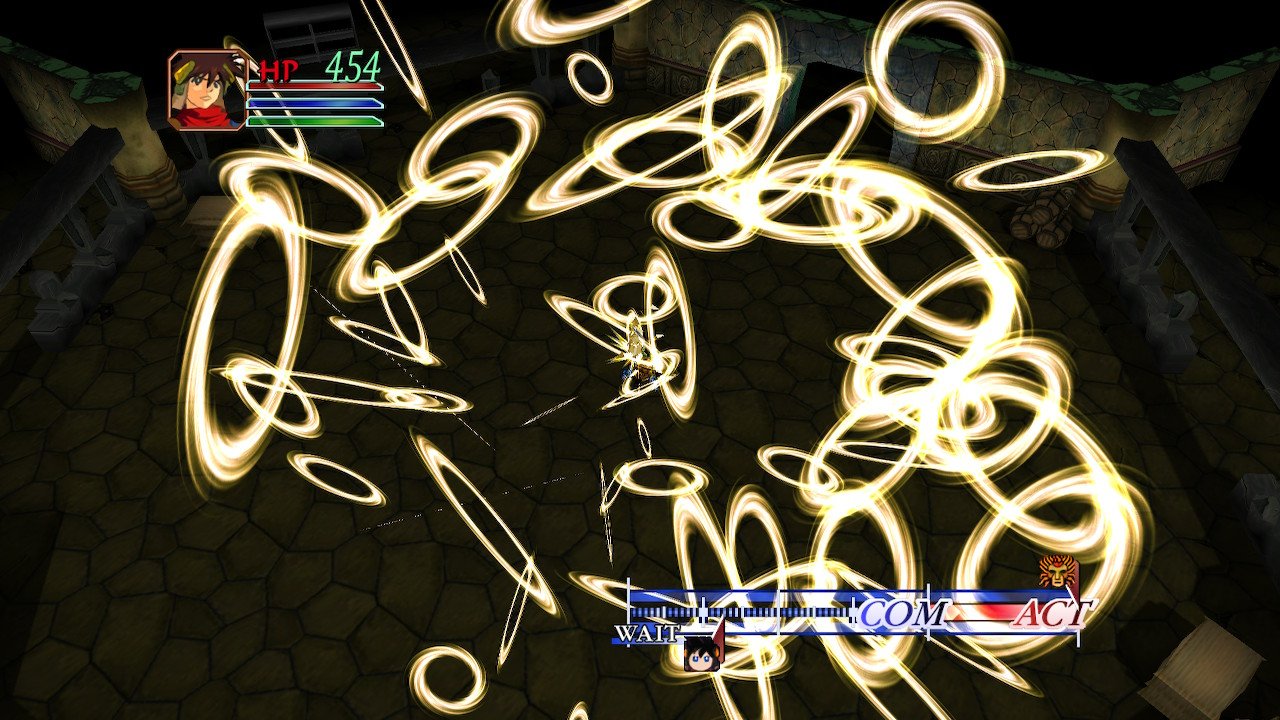
On the other hand, Grandia II is based upon the Dreamcast version (and not using the PlayStation exclusive FMVs). Coming from the early days of 3D, the models are basic but do the job well. Even some of the more surreal looking monsters gain something because of it. Animations can be robotic at times, but clear effort was made even back then to show personality with very little.
While textures are slightly better than Grandia 1’s efforts, there are some graphical issues. Shadows are jagged, spell animations are laid over the top of the screen and run at sub-30 FPS- coming across as just plain ugly. Some of the game’s FMVs are outright hideous, and do not hold up at their new resolution. Character portraits on text boxes can also take a split-second too long change.
There is always a brief pause every time a battle loads, and the frame-rate is curiously higher in battles. Some effects that produce lighting effects do not interact well with the ground (causing only a single poly to be light-up on uneven ground for example).
While both games have clear styles, they are not looking their best here. I did not expect a full blown remake of all assets, and I have come to terms with how “HD” ports are misnomer. A lot of the time I could not help but feel the original graphics made to support wider resolutions would have fared better than some of the attempts made to “improve” them.
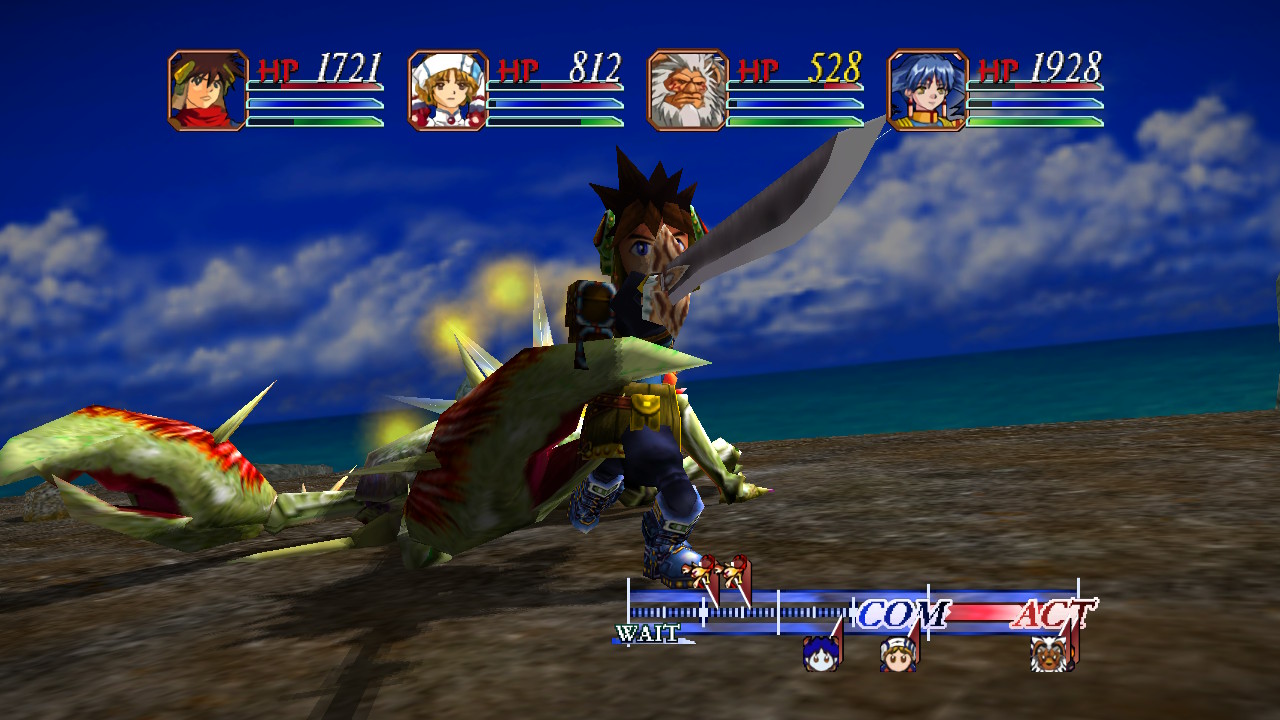
While both games’ music and SFX seem to be the originals, they still sound great. Battle themes do not get repetitive, and are fully of energy- with plenty of synth guitars, choirs, rock organs, and other things deemed novel and hip during the original release. The soundtracks are also diverse, matching the tone of locations and scenes.
Both games also have dual audio (with the ability to switch in-game in Grandia 1). The dub voice acting in both games fail to hold up. While some voices fit, the acting is off almost across the board in Grandia 1. Grandia II favors marginally better with their voices, but there are still plenty of flat performances- including lines said every time when executing skills and spells.
There were glitches and minor issues with audio as well. Voice lines would run into one another with no gap on rare occasion, changing the audio in Grandia 1 may not always change the character’s voices in battle, and music loops sometimes have a slight pause before looping, or not bothering to loop at all.
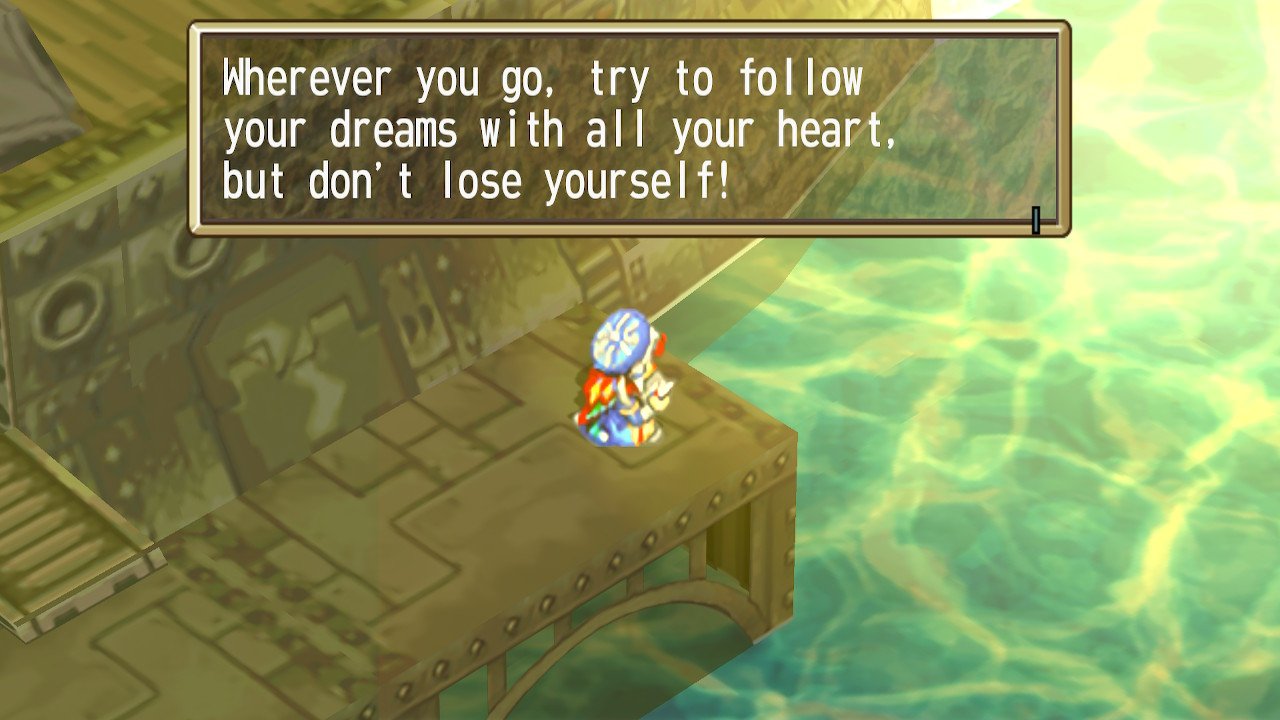
The bad points I have raised must seem condemning. Glitches with graphics and audio, textures and sprites being muddy or ruined, and a game that is a bit easy. All of these feel like foot notes to me however. I greatly enjoyed my time with the games.
Other than the nostalgia trip for the style and presentation of the game, I got into the story – even if its one I had heard a hundred times before with different faces and places. The upbeat and simple Grandia 1 is something especially worth experiencing if your recent media has been morose or cynical.
I do have a hard time recommending the Switch version over earlier PC ports, and hypothetical mods to fix any of the above issues. The price-tag is not entirely unreasonable, and its portability may be a factor for you.
If you never played the original Grandia games, this is the best way to play them – even with a less-than-stellar graphical upgrade. It does bring you back to those long nights spent as a little kid. If you played them before, this is a great way to go on your adventure again.
Grandia HD Collection was reviewed on a Nintendo Switch using a review copy provided by GungHo America. You can find additional information about Niche Gamer’s review/ethics policy here.